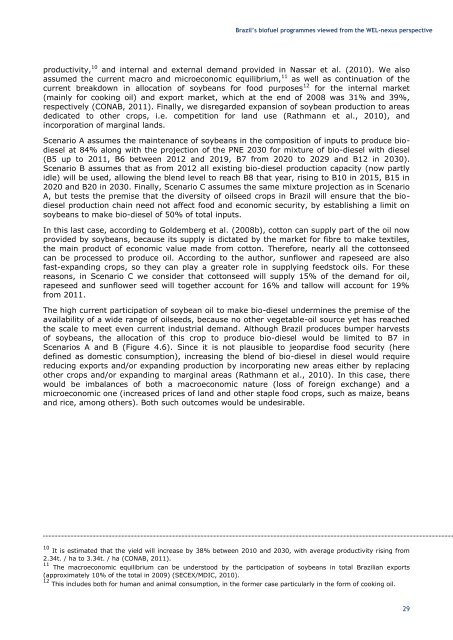Brazilian Biofuels Programmes from the WEL Nexus Perspective
Brazilian Biofuels Programmes from the WEL Nexus Perspective
Brazilian Biofuels Programmes from the WEL Nexus Perspective
- No tags were found...
Create successful ePaper yourself
Turn your PDF publications into a flip-book with our unique Google optimized e-Paper software.
Brazil’s biofuel programmes viewed <strong>from</strong> <strong>the</strong> <strong>WEL</strong>-nexus perspectiveproductivity, 10 and internal and external demand provided in Nassar et al. (2010). We alsoassumed <strong>the</strong> current macro and microeconomic equilibrium, 11 as well as continuation of <strong>the</strong>current breakdown in allocation of soybeans for food purposes 12 for <strong>the</strong> internal market(mainly for cooking oil) and export market, which at <strong>the</strong> end of 2008 was 31% and 39%,respectively (CONAB, 2011). Finally, we disregarded expansion of soybean production to areasdedicated to o<strong>the</strong>r crops, i.e. competition for land use (Rathmann et al., 2010), andincorporation of marginal lands.Scenario A assumes <strong>the</strong> maintenance of soybeans in <strong>the</strong> composition of inputs to produce biodieselat 84% along with <strong>the</strong> projection of <strong>the</strong> PNE 2030 for mixture of bio-diesel with diesel(B5 up to 2011, B6 between 2012 and 2019, B7 <strong>from</strong> 2020 to 2029 and B12 in 2030).Scenario B assumes that as <strong>from</strong> 2012 all existing bio-diesel production capacity (now partlyidle) will be used, allowing <strong>the</strong> blend level to reach B8 that year, rising to B10 in 2015, B15 in2020 and B20 in 2030. Finally, Scenario C assumes <strong>the</strong> same mixture projection as in ScenarioA, but tests <strong>the</strong> premise that <strong>the</strong> diversity of oilseed crops in Brazil will ensure that <strong>the</strong> biodieselproduction chain need not affect food and economic security, by establishing a limit onsoybeans to make bio-diesel of 50% of total inputs.In this last case, according to Goldemberg et al. (2008b), cotton can supply part of <strong>the</strong> oil nowprovided by soybeans, because its supply is dictated by <strong>the</strong> market for fibre to make textiles,<strong>the</strong> main product of economic value made <strong>from</strong> cotton. Therefore, nearly all <strong>the</strong> cottonseedcan be processed to produce oil. According to <strong>the</strong> author, sunflower and rapeseed are alsofast-expanding crops, so <strong>the</strong>y can play a greater role in supplying feedstock oils. For <strong>the</strong>sereasons, in Scenario C we consider that cottonseed will supply 15% of <strong>the</strong> demand for oil,rapeseed and sunflower seed will toge<strong>the</strong>r account for 16% and tallow will account for 19%<strong>from</strong> 2011.The high current participation of soybean oil to make bio-diesel undermines <strong>the</strong> premise of <strong>the</strong>availability of a wide range of oilseeds, because no o<strong>the</strong>r vegetable-oil source yet has reached<strong>the</strong> scale to meet even current industrial demand. Although Brazil produces bumper harvestsof soybeans, <strong>the</strong> allocation of this crop to produce bio-diesel would be limited to B7 inScenarios A and B (Figure 4.6). Since it is not plausible to jeopardise food security (heredefined as domestic consumption), increasing <strong>the</strong> blend of bio-diesel in diesel would requirereducing exports and/or expanding production by incorporating new areas ei<strong>the</strong>r by replacingo<strong>the</strong>r crops and/or expanding to marginal areas (Rathmann et al., 2010). In this case, <strong>the</strong>rewould be imbalances of both a macroeconomic nature (loss of foreign exchange) and amicroeconomic one (increased prices of land and o<strong>the</strong>r staple food crops, such as maize, beansand rice, among o<strong>the</strong>rs). Both such outcomes would be undesirable.10 It is estimated that <strong>the</strong> yield will increase by 38% between 2010 and 2030, with average productivity rising <strong>from</strong>2.34t. / ha to 3.34t. / ha (CONAB, 2011).11 The macroeconomic equilibrium can be understood by <strong>the</strong> participation of soybeans in total <strong>Brazilian</strong> exports(approximately 10% of <strong>the</strong> total in 2009) (SECEX/MDIC, 2010).12 This includes both for human and animal consumption, in <strong>the</strong> former case particularly in <strong>the</strong> form of cooking oil.29
















